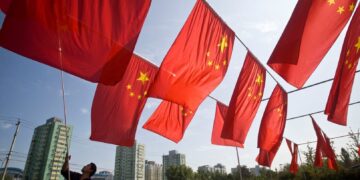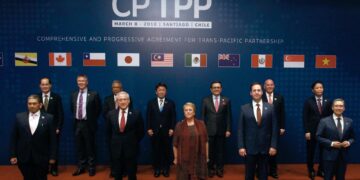The COVID-19 pandemic, and the subsequent shutdowns and economic fluctuations, sent global supply chains into disarray in 2020. Although the economy has seen the beginnings of a recovery, the pandemic will have a lasting effect on how multinational companies manage their supply chains. With companies and governments putting a greater emphasis on supply chain resilience and security, the China Business Review spoke with Dr. Sara Hsu, an author and private consultant to US-based firms who helps executives pinpoint and address Chinese supply chain risks.
CBR: To what extent are the US and Chinese economies “coupled?” How does this affect supply chains?
Dr. Hsu: The US and Chinese economies remain pretty closely coupled, with a lot of trade between the nations and considerable foreign direct investment going from the United States into China. US multinationals have strived to get into China for the past 30 years due to the complex and flexible supply chain relationship between China and Asia, which makes it very easy to obtain inputs and process goods, and due to the vast domestic market in China. Even though labor costs have been rising, they are still lower than in the United States and Europe, and there is a lot of skilled labor in the manufacturing sector, such as toolers; this is far less prevalent in the West. If it wasn’t clear before how integral China is to global supply chains before the trade war and the COVID-19 pandemic, it certainly is now. While the tariffs devastated certain industries, the pandemic prompted shortages of consumer goods, medicine, electronics, auto parts, clothing, and air conditioners, to name a few.
CBR: What factors, geopolitical or other, led to the current situation?
Dr. Hsu: There are several and they all tie into some of the most acute risks for American firms operating in China. First, the US-China trade war. Right now, there are US tariffs on Chinese exports of 19.3% and Chinese tariffs on US exports of 20.7%. The trade war was based on the premise that a US-China trade deficit harms the United States, which is economically false, and on the topic of Chinese intellectual property theft, which has been a serious issue for years. Companies have found various ways to deal with the trade war, lowering other costs to cope with a lower profit margin, or modifying products to be reclassified under the tariff regime.
The US-China conflict over information technology is more complicated. The United States is attempting to decouple with China to some extent in this area. In June, the Biden administration expanded an order, originally implemented during the Trump administration, banning American investment in Chinese firms that support the Chinese military. Not only are there national security issues, but there are also issues associated with supply chain security. These issues are centered around the semiconductor industry, for which manufacturing is mainly focused in East Asia.
The China-Taiwan situation could also create risks for US firms doing business in China. Xi Jinping said at the 100th anniversary of the Chinese Communist Party that China has an “unshakeable commitment” to reunification with Taiwan. The United States, for its part, has been actively building a closer relationship with Taiwan, causing some to wonder if it will depart from its policy of “strategic ambiguity.” Rising threats in and around Taiwan would create major risks to firms manufacturing and shipping goods from China considering the amount of cargo that passes through those waters.
Lastly, intellectual property issues have been longstanding despite the fact that China created a policy on technology transfer by revising its Foreign Investment Law to address this problem. However, there are questions surrounding the ability and willingness of Chinese authorities to enforce the new stipulation, particularly since China has never admitted to stealing intellectual property.
CBR: Which US industries are left most vulnerable in the US-China context?
Dr. Hsu: The most vulnerable industries are the semiconductor and other technology industries, which are experiencing a forced decoupling from China to some extent. The automotive industry has also taken a major hit from the trade war and also from the COVID-19 pandemic, since China plays a central role in producing auto parts. The industry has been particularly affected by the semiconductor shortage. Other industries are highly dependent on production in China, like manufacturers of plastic products, clothing, and medical products.
CBR: Many have said that uncertainty is the new normal. How does a company go about de-risking its supply chain to account for the unknown?
Dr. Hsu: There are several actions companies can take to de-risk their Chinese supply chains. The first is to map their supply chains across tiers. This will help firms to understand the extent to which they are dependent on particular suppliers. More firms are doing this now in order to prevent bottlenecks. The second action that companies can take is digitizing the supply chain. This can improve data collection and end-to-end visibility by tracking raw materials to the finished product, as well as vehicles that transport the goods. Digitization can be used throughout a variety of processes, including inventory management, finance, logistics, operations, quality control, and sales. The third is to model risk assessment under different scenarios in order to identify vulnerabilities and potential risks. This can help firms to prepare for the worst-case scenario, which after COVID-19, seems more like a possibility than in the past. Addressing potential risks allows companies to remain agile even during external disruptions. Finally, US firms may attempt to diversify outside of China. Having the ability to move production to another location if needed can improve supply chain resilience.
CBR: Supply chain shifts away from China have been very a slow creep rather than a mass exodus, with most companies not planning to leave any time soon. Do you see reshoring initiatives accelerating, slowing down, or continuing gradually in the future?
Dr. Hsu: I don’t think full reshoring is a serious option for many US multinationals due to generally higher labor costs. However, I think companies will diversify outside of China to become more agile in their supply chain management and reduce the possibility of disruptions. Some firms have already diversified to Vietnam, Thailand, Malaysia, and Mexico. Vietnam is particularly popular as another supply chain destination due to its low labor costs, while Thailand has improved its ease of doing business, streamlining the process for obtaining construction permits and improving minority investor protection. Malaysia has a strong legal system and well-developed infrastructure. Mexico benefits from its close proximity to the United States and “trusted partner” status for customs. Generally, especially after the pandemic, the focus has shifted away from reshoring to rightshoring, which focuses on placing production in locations that provide better efficiency and lower costs. This means that some critical processes may remain in the United States while others are outsourced to other countries. Rightshoring is leading to lower inventory costs as well as, in some cases, better intellectual property protection. This trend also produces lower lead times, which can help firms address the increasing demand for rapid product fulfillment.






























